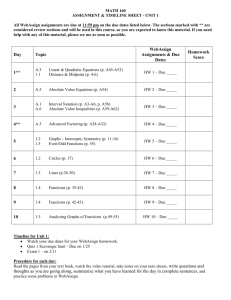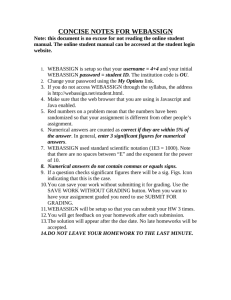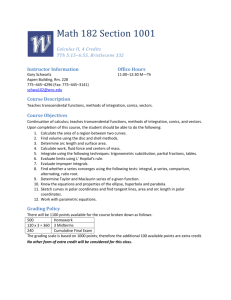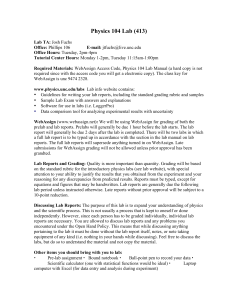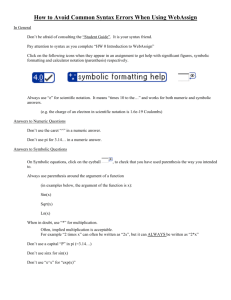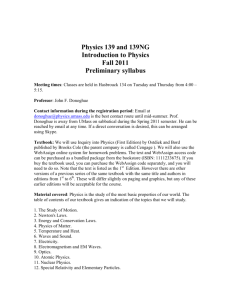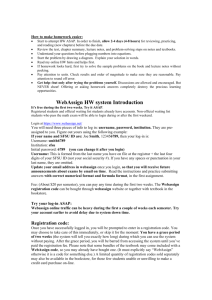Physics 101 - SFSU Physics & Astronomy
advertisement
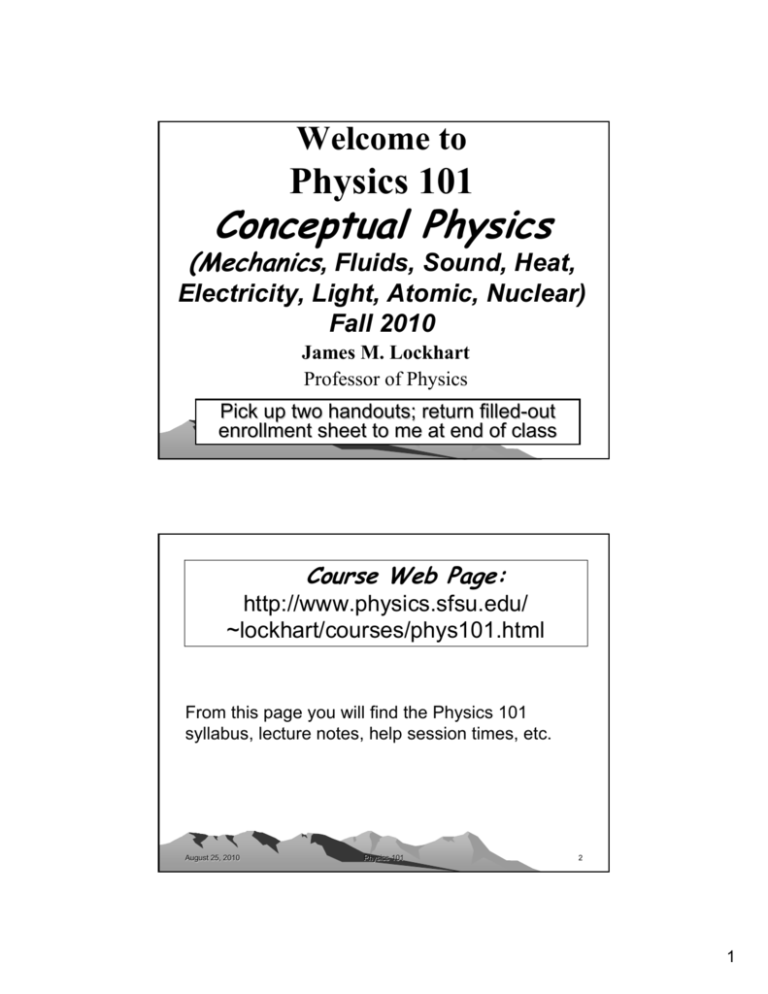
Welcome to Physics 101 Conceptual Physics (Mechanics, Fluids, Sound, Heat, Electricity, Light, Atomic, Nuclear) Fall 2010 James M. Lockhart Professor of Physics Pick up two handouts; return filled-out enrollment sheet to me at end of class Course Web Page: http://www.physics.sfsu.edu/ ~lockhart/courses/phys101.html From this page you will find the Physics 101 syllabus, lecture notes, help session times, etc. August 25, 2010 Physics 101 2 1 Administrative Details (1) Instructor: James M. Lockhart e-mail: jmlock@sfsu.edu Office: Rm. 520 Thornton Hall Tel: (415) 338-2451 Office Hours (tentative): Monday 10:10-11:00, Wed. 1-2, and Friday 10:10-11:00 or by appointment. August 25, 2010 Physics 101 3 Physics 102 Lab • Physics 102 is an optional 1-unit laboratory course associated with Physics 101. • Not required unless you need a lowerdivision science lab for GE requirements. • Must be enrolled in lecture (or have credit for it) to take lab • Can take lecture first and lab in later semester (but not recommended). August 25, 2010 Physics 101 4 2 Administrative Details (3) Textbooks: Paul Hewitt, Conceptual Physics, 11th Ed. (Pearson/AddisonWesley, 2010) (or Hewitt, Conceptual Physics, 10th ed. ) WebAssign access code Lectures: Lectures will be given using a combination of PowerPoint and blackboard. Lecture pdf files available on class web page. Help Sessions: Instructors available for help sessions several hours each week. Help session schedule will be posted on course web page. Exams: Two 50-min. midterms + 2.5-hour final. Final is comprehensive. All exams closed book, but equation sheets provided. NO make-up exams. You must take final as scheduled. Homework: Homework done on WebAssign system; due every lecture day. August 25, 2010 Physics 101 5 Administrative Details (4) WebAssign Information Physics 101 Class List of registered and official wait list students will be uploaded to WebAssign by Friday. Names of those who add from unofficial wait list will show up later. WebAssign is free of cost for first 10 days. After that, you will need to buy a WebAssign access code ($22.95). Available in bundle with textbook, at bookstore, and on-line from WebAssign. WebAssign URL: http://webassign.net/login Logging onto WebAssign (see syllabus for more detail): Your “username” is last name + last 4 digits of SFSU ID; Initial “password” is last 4 digits of your SFSU student ID . Try logging on Friday afternoon. Let me know of problems. August 25, 2010 Physics 101 6 3 About Prof. James M. Lockhart I’m a Professor of Physics, and I’ve taught at SFSU since 1983. Previously taught at Stanford. I do research in superconducting devices and medical physics (MRI and radiation-based cancer treatment). I’m also involved in a satellite-based test of Einstein’s theory of General Relativity. Outside interests include music (guitar and saxophone), audio recording, hiking/climbing. August 25, 2010 Physics 101 7 Agenda for this week: Today: Intro, units, dimensions, scientific notation Friday: Newton’s First Law, Forces August 25, 2010 Physics 101 8 4 Lecture 1: Units, Dimensions, Scientific Notation Some illustrations courtesy of Prof. J.G. Cramer, U of Washington August 25, 2010 Physics 101 9 Physics and the Laws of Nature Physics: the study of the fundamental laws of nature. Foundation of all physical science These laws can be expressed as mathematical equations. (e.g., F = m a) that relate physical quantities Most physical quantities have units, which must match on both sides of an equation. ● ● August 25, 2010 Physics 101 10 5 Units With a few exceptions, all physical quantities have units. Examples: Mass kilograms (kg) Speed meters per second (m/s) Pressure pascals (P) Energy joules (J) Temperature kelvins (K) The units of almost all physical quantities can be expressed as combinations of only the units for mass, length, and time, i.e., kilograms, meters, and seconds. A few physical quantities are pure numbers that have no associated units. August 25, 2010 Physics 101 11 Systems of Measurement • Standardized systems – agreed upon by some authority, usually a governmental body • SI -- Systéme International – agreed to in 1960 by an international committee – main system used in this course, and in all science – also called mks for the first letters in the units of the fundamental quantities August 25, 2010 Physics 101 12 6 Standard International Units Standard International (SI) Base Units • Length: meter • Mass: kilogram • Time: second • Temperature kelvins • Current Ampere Light level candela m kg s K A cd Units for almost all other physical quantities can be constructed from the base units of mass, length, and time. inches, feet, miles pounds miles/hour Fahrenheit degrees } English Units (Used only in USA, Liberia, and Myanmar) Note: English pound unit is a measure of force or weight, not mass. A kilogram has a weight of 2.20 pounds at standard gravity. August 25, 2010 Physics 101 13 Conversions • When units are not consistent or are not given in SI, you may need to convert to appropriate ones • Units can be treated like algebraic quantities that can cancel each other out • Write conversion factors as a fraction of value 1 and arrange to cancel out undesired units 1 mile = 1609 m = 1.609 km 1m = 39.37 in = 3.281 ft 1 ft = 0.3048 m = 30.48 cm 1 in = 0.0254 m = 2.54 cm 1mi =1 1.609km August 25, 2010 0.0254m =1 1inch Physics 101 14 7 Example 1. Scotch tape: 450inch • Example 2. Trip to Canada: 0.0254m = 11.4m 1inch Freeway speed limit in Canada is 100 km/h. In miles/h? 100 August 25, 2010 km km 1 mile miles = 100 ⋅ ≈ 62 h h 1.609 km h Physics 101 15 The SI Time Unit: second (s) Cesium Fountain Clock 13th Century Water Clock The second was originally defined as (1/60)(1/60)(1/24) of a mean solar day. Currently, second is defined as time for 9,192,631,770 oscillations of the radio waves absorbed by a vapor of cesium-133 atoms. August 25, 2010 Physics 101 16 8 The SI Length Unit: meter (m) Meter originally defined as 1/10,000,000 of distance from Earth’s equator to North pole on line of longitude passing through Paris. Later defined as distance between two scratches on a particular platinum-iridium bar. Currently, 1 meter defined as distance traveled by light in 1/299,792,458 of a second August 25, 2010 Physics 101 17 The SI Mass Unit: kilogram (kg) The kilogram was originally defined as the mass of 1 liter of water at 4oC. Currently, 1 kilogram is the mass of the international standard kilogram, a polished platinum-iridium cylinder stored in Sèveres, France. (It is currently the only SI unit defined by a manufactured object.) Why the glass domes?? August 25, 2010 Physics 101 18 9 August 25, 2010 Physics 101 19 Dimensional Analysis • Dimension denotes the physical nature of a quantity (length, time, length/time, ...) • Dimensional Analysis - Technique to check the correctness of an equation • Dimensions ([L] length, [M] mass, [T] time, & combinations) can be treated as algebraic quantities – add, subtract, multiply, divide – quantities added/subtracted only if have same units • Both sides of an equation must have the same dimensions August 25, 2010 Physics 101 20 10 Significant Figures & Sci. Notation • A significant figure is one that is reliably known • All non-zero digits are significant • Zeros are significant when – between other non-zero digits – after the decimal point and another significant figure • can be clarified by using scientific notation 17400 = 1.74 ×10 4 3 significant figures 17400. = 1.7400 ×10 4 5 significant figures 17400.0 = 1.74000 ×10 4 6 significant figures August 25, 2010 Physics 101 21 Operations with Significant Figures • Precision -- number of significant figures : • When multiplying or dividing, round the result to the same precision as the least precise measurement Example: rectangular plate: 4.5 cm by 7.3 cm 2 significant figs. area: 32.85 cm2 33 cm2 • When adding or subtracting, round the result to the smallest number of decimal places of any term in the sum Example: 135 m + 6.213 m = 141 m August 25, 2010 Physics 101 22 11 Key Points of Lecture 1 • SI System of units; base (m, kg, s, K) and derived units • Treat units as algebraic quantities; convert with “unity fractions” • Both sides of equation need same dimensions; so do things added or subtracted • Scientific Notation: Write numbers as a set of significant figures multiplied by a power or 10. Before Friday lecture, read Hewitt, first half of Chap. 2 August 25, 2010 Physics 101 23 12
